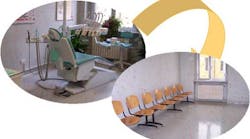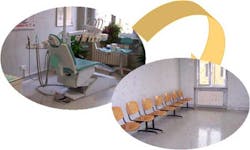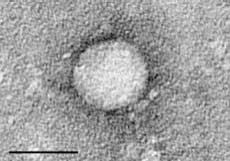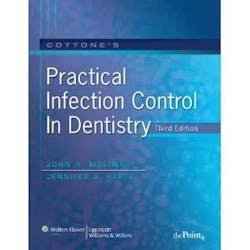Global decontamination: An ethical duty or benefit for a few?
June 2, 2011
By Olivia Marchisio, RDH, DHA
Currently, there are different types of infections that could interfere with the clinical approach to our patients. These infections could be viral, bacterial or fungal.(1) The risk of cross contamination and acquiring infections in the daily practice comes from a variety of sources: the blood-borne route, saliva route, water droplet route, and direct contact.(2) Of these, the most important one is the water droplet route, where small drops of water are mixed with pathogens and can reach all surfaces in an area of three meters as an aereosol. In a study done by Motta et al. in 2005,(3) it was shown that the most infected part of the clinical operatory is the dental chair dashboard, or panel; the light handle; the air/water syringe; and the handle of the door. The pathogens most represented were Streptococci [(S. mutans, S. sanguis, S. salivarius, S. mitior) e A. milleri, Sthaphylococcus epidermidis, Bacillus Subtilis].
In another study done at the University of Rome, Sapienza, on 100 dental chairs, researchers showed the presence of pathogens in liquid aerosolized by turbine sprays. 100% of sprays were contaminated by oral pathogens.(4) Moreover, in dental chairs used only for hepatitis C (HCV) patients, in seven cases of 10, it was determined that the HCV virus was in the fluid of the turbine spray after the dental treatment.(5)Based on these considerations, the best way to avoid infection is through infection control practices such as:1. increasing the clinician’s protection (where possible);2. decreasing the pathogen load on instruments, in the room, and on surfaces.
The importance of having an aseptic clinical operatory before and after therapy, as much as possible, is a conditio si ne qua non (a paradigm meaning: "[a condition] without which it could not be,"). In other words, it is necessary to have a disinfected operatory in order to provide efficient therapy. So it follows that it is important to follow good disinfection and sterilization protocols, as well as decontamination protocols for surfaces, chairs, and all the environment. The path to the success of therapy, and to facilitate the healing process, is an antiseptic environment. The goal of any clinical intervention is enhanced by use of correct sanitization procedures in the clinical/ work environment and operative field. It follows that the ability to motivate patients and obtain compliance is necessary in order to maintain the least possible bacterial load. Bacterial load reduction in the oral cavity, as well as in the surgical layout, is a pivotal step in the clinical approach to the patient and in the success of treatment.
We always speak about quality in the clinical practice. We must always keep in mind that in our practices, the first step is to obtain and maintain high quality levels and to treat all patients with high standards of decontamination. This should be done not only in the mouth, but also in the total environment related to the mouth such as instruments, the operatory surfaces, and other items related to patient care.References
1. William G. et al. “Guideline for infection control in dental health care settings-2003.”J Am Dent Ass. 2004 Jan; 135(1) 33-47.2. Marchisio O. , Genovesi A. Infection control : an ethical duty for the dentistry team. Dental Tribune-Italian Edition Sept; IV (9) pp-6-7.3. Motta RH, Ramacciato JC, Groppo FC, Pacheco Ade B, de Mattos-Filho TR. Environmental contamination before, during, and after dental treatment. Am J Dent. 2005 Oct;18(5):340-4.4. Dolci G. et al. Project MIUR n° 6433/DSPAR/0:“Studio del rischio di infezioni crociate virali e batteriche in odontoiatria e messa a punto di modifiche della strumentazione idonee alla prevenzione”/ “Viral and bacterial infection control risk in dentistry. Setup of suitable intrumentation for risk prevention and control”. International Multicentric Study directed with the support of the Italian Ministry of Instruction, University and Research.5. Artini M, Scoarughi GL, Papa R, Dolci G, De Luca M, Orsini G, Pappalardo S, Costerton JW, Selan L. Specific anti cross-infection measures may help to prevent viral contamination of dental unit waterlines: a pilot study. Infection. 2008 Oct;36(5):467-71.Note: This article is based upon the presentation Marchisio made at SISIO.
1. William G. et al. “Guideline for infection control in dental health care settings-2003.”J Am Dent Ass. 2004 Jan; 135(1) 33-47.2. Marchisio O. , Genovesi A. Infection control : an ethical duty for the dentistry team. Dental Tribune-Italian Edition Sept; IV (9) pp-6-7.3. Motta RH, Ramacciato JC, Groppo FC, Pacheco Ade B, de Mattos-Filho TR. Environmental contamination before, during, and after dental treatment. Am J Dent. 2005 Oct;18(5):340-4.4. Dolci G. et al. Project MIUR n° 6433/DSPAR/0:“Studio del rischio di infezioni crociate virali e batteriche in odontoiatria e messa a punto di modifiche della strumentazione idonee alla prevenzione”/ “Viral and bacterial infection control risk in dentistry. Setup of suitable intrumentation for risk prevention and control”. International Multicentric Study directed with the support of the Italian Ministry of Instruction, University and Research.5. Artini M, Scoarughi GL, Papa R, Dolci G, De Luca M, Orsini G, Pappalardo S, Costerton JW, Selan L. Specific anti cross-infection measures may help to prevent viral contamination of dental unit waterlines: a pilot study. Infection. 2008 Oct;36(5):467-71.Note: This article is based upon the presentation Marchisio made at SISIO.
Olivia Marchisio, RDH, DHA, is a PhD student.











